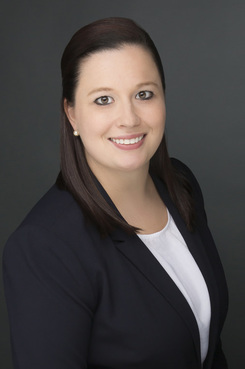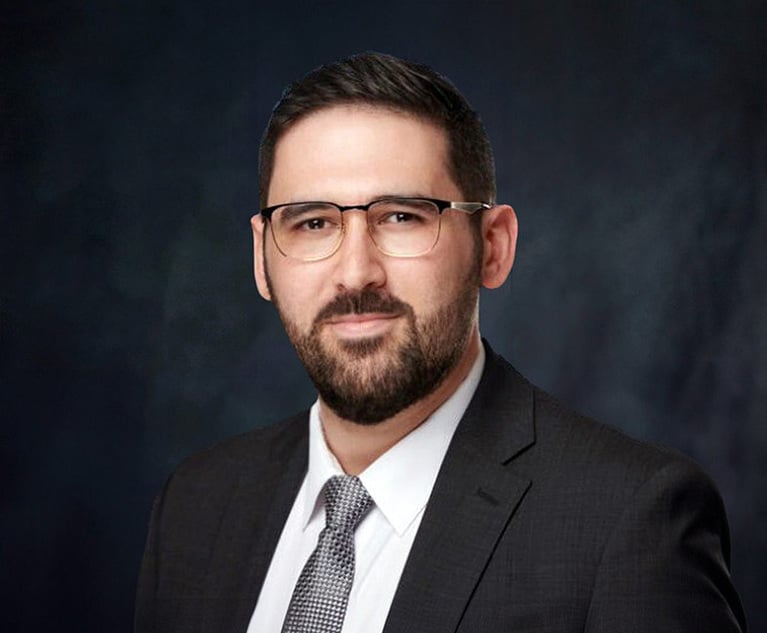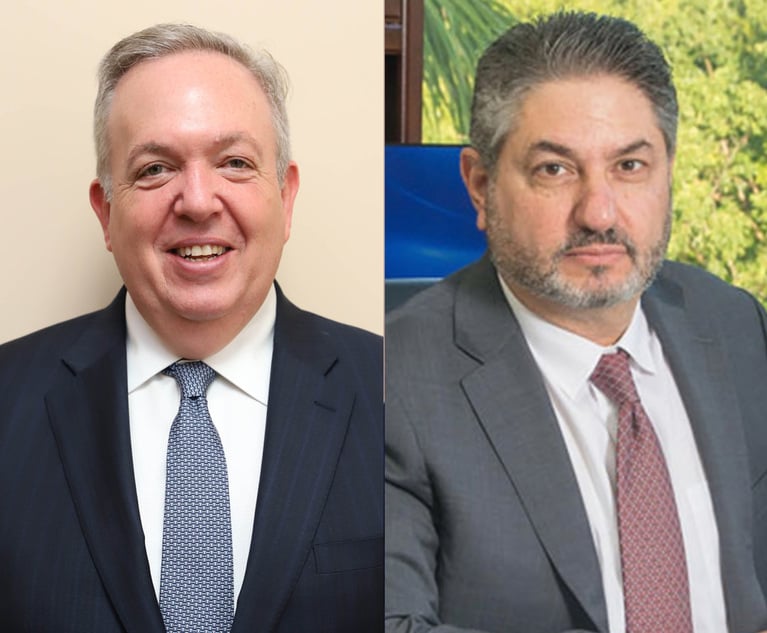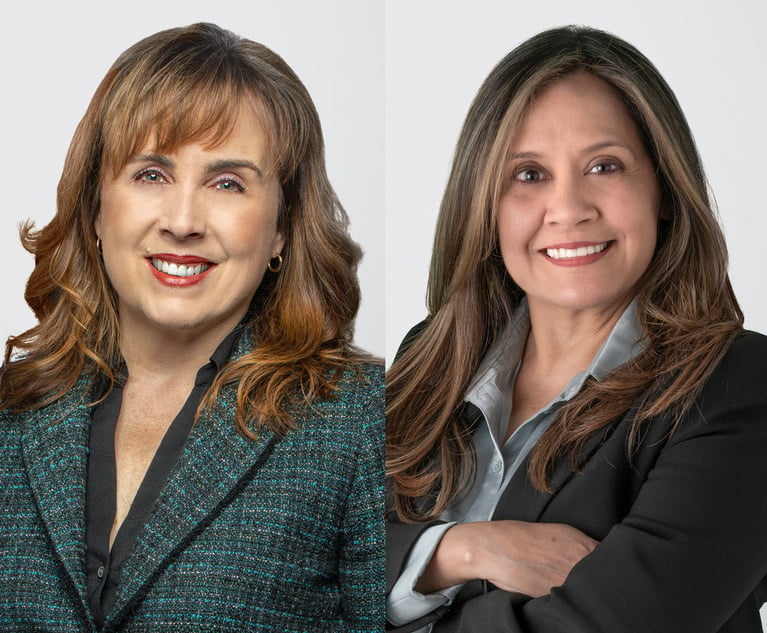11th Circ.: Direct Payments to a Secured Creditor in a Chapter 13 Bankruptcy Are Not Discharged
On Dec. 6, 2018, the U.S. Court of Appeals for the Eleventh Circuit held that a Chapter 13 plan stating that a secured debt will be paid directly to the creditor does not constitute the debt being “provided for” by the plan, and thereby precluding a discharge of that debt.
January 15, 2019 at 10:30 AM
5 minute read
 Christina Paradowski, Director, Tripp Scott inFort Lauderdale (Photo: Courtesy photo).
Christina Paradowski, Director, Tripp Scott inFort Lauderdale (Photo: Courtesy photo).
On Dec. 6, 2018, the U.S. Court of Appeals for the Eleventh Circuit held that a Chapter 13 plan stating that a secured debt will be paid directly to the creditor does not constitute the debt being “provided for” by the plan, and thereby precluding a discharge of that debt. In Dukes v. Suncoast Credit Union, Case No. 16-16513, in the U.S. Court of Appeals for the Eleventh Circuit, the ruling by the Eleventh Circuit will not only have a profound impact upon consumers who file for Chapter 13 bankruptcy protection, but also on secured lenders who may wish to collect deficiency balances against debtors, but have otherwise been reticent to do so thus far.
Factual History
In early 2009, Mildred M. Dukes filed for Chapter 13 bankruptcy protection, seeking to reorganize and repay her debts according to certain stated conditions. Included in her schedules were two mortgages with Suncoast Credit Union, each secured by Dukes' principal residence, totaling approximately $150,000, and not due to mature until 2022.
Dukes submitted her plan of reorganization, and included both Suncoast mortgages in the portion of the plan titled “Paid directly to the Creditor.” Significantly, Dukes did not include the Suncoast mortgages in the section addressing claims secured by real property which she intended to retain and mortgage payments paid through the plan. Additionally, while the plan included Dukes' calculation of her debt burden and plan payment schedule, the Suncoast mortgages were not included in either. Suncoast did not file any objection to Dukes' plan.
In May 2010, the Bankruptcy Court for the Middle District of Florida confirmed Duke's plan of reorganization, under which Suncoast would not receive any payment or distribution from the Chapter 13 Trustee. Dukes timely completed all payment obligations under the plan, and, in March 2012, was granted a discharge of “all debts provided for by the plan” under Section 1328(a) of the Bankruptcy Code.
During this time, Dukes continued to make some payments directly to Suncoast, but by 2011, the payments had ceased. With the mortgages in default, in 2013, Suncoast foreclosed on the home under the second mortgage, and pursued a personal judgment against Dukes on the first. Suncoast then reopened Dukes' bankruptcy case and initiated an adversary proceeding seeking a determination that Dukes remained personally liable for the first mortgage—i.e., that the debt on the first mortgage had not been discharged.
Lower Courts
The Bankruptcy Court for the Middle District of Florida ruled in Suncoast's favor, finding that the mortgage debt had not been discharged because it was to be paid outside the plan, and thus remained unaffected by the plan itself. In other words, the Bankruptcy Court found that the mortgage had not been “provided for” by the plan as required for a discharge under Section 1328(a). Additionally, the Bankruptcy Court held that, even if the mortgage had been “provided for” by the plan, the antimodification provision of Section 1322(b)(2) prohibited the discharge. The District Court for the Middle District of Florida affirmed on all grounds, and Dukes appealed.
Eleventh Circuit
Relying upon the U.S. Supreme Court's opinion in Rake v. Wade, 508 U.S. 464 (1993), the Eleventh Circuit, upheld the decisions of the District and Bankruptcy Courts, reasoning, primarily, that for a debt to be “provided for” in a plan, the plan must “make a provision for” or “stipulate to” the debt—i.e., set forth a payment schedule or modify the terms of the instrument. In Dukes' case, however, the plan did neither of these things. Instead, because Dukes' plan merely stated that Suncoast's mortgage would be paid outside the plan, the Eleventh Circuit determined that Suncoast's rights and Duke's liability under the mortgage were governed solely by the original loan documents.
In so holding, the Eleventh Circuit expressly rejected Duke's argument that merely mentioning or referring to the debt was sufficient for the debt to be “provided for” by the plan. Specifically, the court found that, aside from stating it would be paid directly, Suncoast was not addressed in the plan, and thus received no notice that its rights would be modified. To allow otherwise would permit a debtor to unilaterally deprive a secured creditor of its rights in contravention of Section 1325(a)(5)'s express requirements. Finally, to avoid any doubt, the Eleventh Circuit concluded that, even if “provided for” by the plan, the mortgage debt still would not be discharged due to Section 1332(b)(2)'s antimodification provision. As a result, the Eleventh Circuit found that Dukes remained personally liable.
Conclusion
The opinion by the Eleventh Circuit is a cautionary tale for any consumer-debtor in a Chapter 13 case. At the same time, it provides some salvation for secured lenders, such as mortgagees and automobile finance companies, who were otherwise hesitant to pursue debtors for deficiency balances at the risk of violating the discharge injunction.
Christina Paradowski is director with Tripp Scott and focuses her practice in the areas of creditors' rights, commercial litigation, and general civil litigation.
This content has been archived. It is available through our partners, LexisNexis® and Bloomberg Law.
To view this content, please continue to their sites.
Not a Lexis Subscriber?
Subscribe Now
Not a Bloomberg Law Subscriber?
Subscribe Now
NOT FOR REPRINT
© 2025 ALM Global, LLC, All Rights Reserved. Request academic re-use from www.copyright.com. All other uses, submit a request to [email protected]. For more information visit Asset & Logo Licensing.
You Might Like
View All
Conversation Catalyst: Transforming Professional Advancement Through Strategic Dialogue
5 minute read
SEC Whistleblower Program: What to Expect Under the Trump Administration
6 minute read
Turning the Shock of a January Marital Split Into Effective Strategies for Your Well-Being
5 minute read
Trending Stories
- 1SEC Sued for Failing to Reveal Records Involving Simpson Thacher Attorney
- 2Lawsuit accuses University of California of racial discrimination in admissions
- 3Data Breaches in UK Legal Sector Surge, According to ICO Data
- 4PayPal Faces New Round of Claims; This Time Alleging Its 'Honey' Browser Extension Cheated Consumers
- 5Fired NLRB Member Seeks Reinstatement, Challenges President's Removal Power
Who Got The Work
J. Brugh Lower of Gibbons has entered an appearance for industrial equipment supplier Devco Corporation in a pending trademark infringement lawsuit. The suit, accusing the defendant of selling knock-off Graco products, was filed Dec. 18 in New Jersey District Court by Rivkin Radler on behalf of Graco Inc. and Graco Minnesota. The case, assigned to U.S. District Judge Zahid N. Quraishi, is 3:24-cv-11294, Graco Inc. et al v. Devco Corporation.
Who Got The Work
Rebecca Maller-Stein and Kent A. Yalowitz of Arnold & Porter Kaye Scholer have entered their appearances for Hanaco Venture Capital and its executives, Lior Prosor and David Frankel, in a pending securities lawsuit. The action, filed on Dec. 24 in New York Southern District Court by Zell, Aron & Co. on behalf of Goldeneye Advisors, accuses the defendants of negligently and fraudulently managing the plaintiff's $1 million investment. The case, assigned to U.S. District Judge Vernon S. Broderick, is 1:24-cv-09918, Goldeneye Advisors, LLC v. Hanaco Venture Capital, Ltd. et al.
Who Got The Work
Attorneys from A&O Shearman has stepped in as defense counsel for Toronto-Dominion Bank and other defendants in a pending securities class action. The suit, filed Dec. 11 in New York Southern District Court by Bleichmar Fonti & Auld, accuses the defendants of concealing the bank's 'pervasive' deficiencies in regards to its compliance with the Bank Secrecy Act and the quality of its anti-money laundering controls. The case, assigned to U.S. District Judge Arun Subramanian, is 1:24-cv-09445, Gonzalez v. The Toronto-Dominion Bank et al.
Who Got The Work
Crown Castle International, a Pennsylvania company providing shared communications infrastructure, has turned to Luke D. Wolf of Gordon Rees Scully Mansukhani to fend off a pending breach-of-contract lawsuit. The court action, filed Nov. 25 in Michigan Eastern District Court by Hooper Hathaway PC on behalf of The Town Residences LLC, accuses Crown Castle of failing to transfer approximately $30,000 in utility payments from T-Mobile in breach of a roof-top lease and assignment agreement. The case, assigned to U.S. District Judge Susan K. Declercq, is 2:24-cv-13131, The Town Residences LLC v. T-Mobile US, Inc. et al.
Who Got The Work
Wilfred P. Coronato and Daniel M. Schwartz of McCarter & English have stepped in as defense counsel to Electrolux Home Products Inc. in a pending product liability lawsuit. The court action, filed Nov. 26 in New York Eastern District Court by Poulos Lopiccolo PC and Nagel Rice LLP on behalf of David Stern, alleges that the defendant's refrigerators’ drawers and shelving repeatedly break and fall apart within months after purchase. The case, assigned to U.S. District Judge Joan M. Azrack, is 2:24-cv-08204, Stern v. Electrolux Home Products, Inc.
Featured Firms
Law Offices of Gary Martin Hays & Associates, P.C.
(470) 294-1674
Law Offices of Mark E. Salomone
(857) 444-6468
Smith & Hassler
(713) 739-1250






